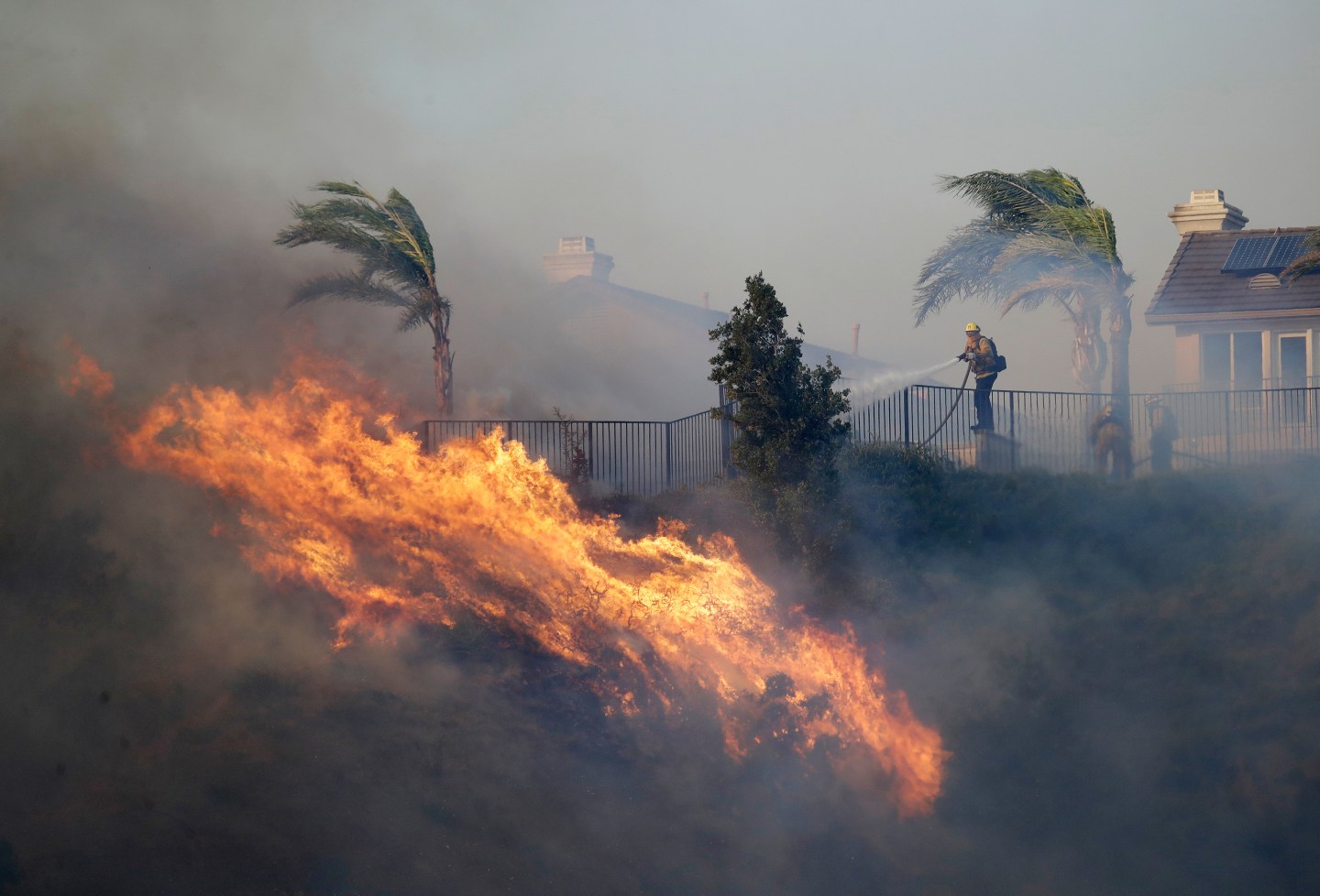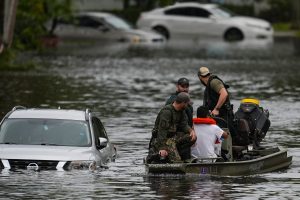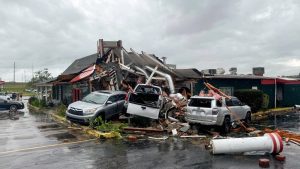Hurricane Milton’s Tornado Outbreak: How 41 Twisters Changed Florida Forever
USA NEWS – Hurricane Milton, a force of nature that recently made landfall in Florida, has not only been devastating due to its ferocious winds and heavy rains but has also produced a startling number of tornadoes, making it one of the most tornado-generating hurricanes in recent U.S. history. As of Friday, meteorologists from the National Weather Service (NWS) confirmed that the hurricane spawned at least 41 tornadoes, though this figure is likely to rise as damage assessments continue across the state. These tornadoes, which wreaked havoc across Florida, have left behind a trail of destruction, with some areas still recovering from the shock and devastation of Milton’s fury. The storm is expected to climb up the ranks of tornado-producing hurricanes as more damage reports come in.
The impact of Hurricane Milton’s tornadoes was widespread, with weather service teams from multiple regions of Florida spending more than a week in the field, assessing the damage left in its wake. These tornadoes, which stripped roofs from homes, flipped mobile houses, and hurled cars and boats like toys, were responsible for significant devastation, including a tragic incident in St. Lucie County, where six people lost their lives. Milton’s unprecedented tornado activity has placed it among the most prolific tornado-spawning hurricanes in recent history. According to data from the National Oceanic and Atmospheric Administration (NOAA), the storm could potentially be ranked as the 13th highest in terms of tornadoes produced by a single hurricane since 1995, a list dominated by some of the most destructive hurricanes in U.S. history.
While the current tally of tornadoes is already significant, meteorologists are continuing to investigate additional reports of damage, which could push the final count even higher. In particular, the NWS office in Tampa Bay is still assessing reports in its region, and if one more tornado is confirmed, Hurricane Milton could surpass Hurricane Jeanne from 2004, moving into 12th place for the most tornadoes generated by a hurricane. This would place Milton in the upper echelons of tornado-producing storms, a testament to the extreme weather patterns observed during its progression across Florida.
Hurricane Milton’s approach to Florida was particularly alarming due to the sheer intensity of its winds. Meteorologists reported that wind speeds around the storm’s eyewall peaked at a staggering 180 mph just 24 hours before it made landfall on Florida’s Siesta Key. Even before Milton reached the coastline, its outer bands began unleashing storms across South Florida, more than 16 hours ahead of its actual landfall. These storms laid the groundwork for the tornadoes that would later emerge, fueled by a perfect storm of conditions that meteorologists describe as the ideal recipe for tornado formation.
Sammy Hadi, a meteorologist with the NWS in Miami, emphasized that tornadoes associated with hurricanes can often strike far from the storm’s center. In Milton’s case, the first tornado was recorded more than 300 miles away from the storm’s center, near Florida City, just after 4 a.m. The tornadoes formed on the northeastern side of Milton, a region often referred to as the “dirty side” of hurricanes due to its tendency to generate severe weather. According to William Ulrich, the warning coordination meteorologist for the NWS office in Melbourne, Florida, the northeast quadrant is where tornadoes are most likely to occur. He explained that three primary factors – dry air, instability, and wind shear – combined to create the conditions that allowed these tornadoes to form, making this quadrant especially dangerous.
As Hurricane Milton moved west to east, its path placed Central and South Florida squarely in the dangerous northeastern quadrant. This positioning, coupled with daytime heating, dry air wrapping around the southern side of the storm, and shifting wind patterns, created a volatile environment perfect for tornado formation. Meteorologists reported that as the sun rose on the day of Milton’s landfall, it further destabilized the atmosphere, providing the necessary energy to produce strong thunderstorms. These storms, in turn, fueled the development of rotating supercell thunderstorms, which are often responsible for spawning tornadoes.
The extent of the damage caused by these tornadoes is still being uncovered, and it may be impossible to determine exactly how many tornadoes were produced by Hurricane Milton. Some of the tornadoes occurred over remote areas of the Everglades and other rural parts of South Florida, limiting the ability of meteorologists to conduct detailed surveys. Hadi explained that many of these regions are difficult to access, making it hard to assess the full extent of the tornado activity. Despite these challenges, the NWS in Miami has already confirmed a record-breaking 15 tornadoes in a single day, surpassing the previous record of seven. The Miami office also issued an unprecedented 55 tornado warnings, highlighting the scale of the threat posed by Milton.
The Melbourne weather service office recorded 19 tornadoes, including two that crossed over from the Miami region. This, too, set a single-day record for the Melbourne office, which has been monitoring weather conditions in the area for 35 years. Meanwhile, the Tampa Bay weather service office, based in Ruskin, had tallied nine tornadoes as of Friday evening. Meteorologist Jennifer Hubbard from the Tampa office indicated that more tornadoes might be confirmed in the coming days as teams continue their surveys.
Hurricane Milton is not the only storm to have produced an exceptional number of tornadoes in 2024. Earlier in the year, Hurricane Beryl made landfall along the Texas coast and spawned an estimated 65 tornadoes. According to Roger Edwards, a lead forecaster at NOAA’s Storm Prediction Center, Beryl is expected to rank as the fifth-highest tornado-producing hurricane after a final analysis of the 2024 season. These statistics underscore the increasing frequency and intensity of tornado-producing hurricanes, a trend that has been observed since the advent of Doppler radar in 1995. Over the past three decades, hurricanes and tropical storms have spawned more than 1,700 tornadoes, a stark reminder of the dangers posed by these powerful weather systems.
In terms of damage, Milton’s tornadoes were responsible for a range of destruction, from minor wind damage to catastrophic EF-3 tornadoes that caused significant loss of life and property. Three EF-3 tornadoes were documented during the storm, including one that tragically killed six people in the Spanish Lakes community near Fort Pierce and Vero Beach. This tornado, which reached peak winds of 155 mph, traveled over 21 miles and left a trail of devastation in its path. The Spanish Lakes community, home to many manufactured houses, was particularly hard-hit, with more than 20 homes being flipped or tossed from their foundations.
In Glades County, another EF-3 tornado produced winds of 140 mph, traveling more than 15 miles and causing widespread damage to homes and infrastructure. Meanwhile, in Palm Beach County, a third EF-3 tornado reached peak winds of 140 mph and traveled nearly 29 miles, toppling roofs and flipping vehicles. These tornadoes left behind a landscape of destruction, with homes demolished, cars tossed hundreds of yards, and entire communities struggling to rebuild in the aftermath of Milton’s rampage.
As recovery efforts continue, Florida residents are grappling with the widespread damage caused by Hurricane Milton’s unprecedented tornado activity. The storm has left a lasting impact on the state, serving as a stark reminder of the powerful and unpredictable nature of hurricanes and the destruction they can bring far beyond their immediate path.



